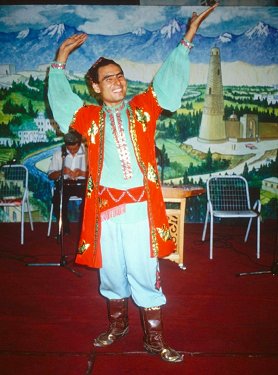
Silk Road Splendours
Sunday - 1 Aug 2010
On the Road in
,
the Northwest of
-
China
|
|

Colourful folk dances along the Silk Road
|
Along the World's Most Historic Road
About 2000 years ago camel caravans began to become a frequent sight on the fabled Silk Road that linked China and Europe.
In all there were some 30 countries located along not just one road but several ancient trading paths that spanned the immense distance between East and West.
The southernmost route was by sea, skirting Southeast Asia, India and the coastline of Arabia. The northernmost route was overland across Russia.
In between were several Trans Asia trade routes that passed through China. Along the 5000-km portion of the major route that travelled through the Middle Kingdom there are still numerous monuments and landmarks from days long gone.
Many journeys along the Silk Road begin in Xi'an in Shaanxi Province and progress to Lanzhou, the Jiayuguan Pass, Dunhuang, Turpan, Urumqi and Kashgar.
Xi'an, best known for its thousands of terracotta soldiers and their lifelike horses, is the Chang'an of old. This city in northwest China was the political hub of China for 11 dynasties.
It was from Chang'an that the Chinese Emperor, Wudi sent his envoy Zhang Quan on a secret mission to the West about 2135 years ago.
Zhang Quan and the countless others to follow him made their first major stop in Lanzhou, the capital of Gansu Province and a former garrison town on the Yellow River.
A few hours outside the city are the Bingling Si Caves where 694 statues of Buddha were carved into the cliff face of a 60 metre high canyon.
Jiayuguan, another garrison town in northern Gansu, marks the end of the Great Wall. In ancient days it also denoted the western boundary of the vast Chinese Empire.
Beyond this outpost at the edge of the Gobi Desert the stark landscape is of a pebble-strewn wasteland backdropped by distant snow-capped mountains.
Dunhuang is an oasis town getting used to a new breed of traveller. Camel caravans don't pass through the town anymore; tourist coaches have replaced them.
While camels can be hired for sunrise safaris the main reason visitors come here is to see the Margao Grottos.
Driving for a half hour on a modern hard surfaced road that cuts across the harsh terrain of the Gobi we arrived at what's considered the world's oldest, richest, largest and most valuable grotto art museum.
There are some 45,000 sq. metres of murals sheltered in a 1600 metre long 'gallery'.
Listed as one of the world's cultural heritages by UNESCO there are some 492 surviving caves with the earliest dating from the 4th century.
Further on is another oasis town, Turpan, where the character is decidedly Central Asian.
Situated at the lowest point in China, Turpan, one of the hottest places in the country, is studded with outstanding architectural and historic jewels.
Rising above all perhaps is Gaochang, one of the world's great lost cities. Construction started here in the 1st century by garrison troops.
While the vast city was destroyed by the Mongolians in the 14th century efforts are being made today to restore some of its many ruins.
After visiting other places like the Turpan Minaret which was covered in 7000 grams of silver and the tombs at Astana which contain 1300 year old mummies you may be ready for refreshments.
Turpan's location in a deep basin - the second lowest place on the planet - may mean hot summers but the warm and dry conditions are idyllic for wine production.
Grapes have been grown in the area since Silk Road days but the wine industry is just 50 years old. At 'Grape Valley' visitors can sip reds and whites at $1 a glass in cool, vine-covered surrounds.
That was one surprise of the Silk Road. Another was the sophistication of Urumqi, a large industrial city and regional capital.
For many travellers this is the end of their overland journey. After a day exploring the old markets in the city and perhaps making an excursion to Heavenly Lake they fly back to Beijing or Guangzhou and connect with onward overseas flights.
The portion of the Silk Road that wove its way through China didn't, of course, stop at Urumqi. It carried on to Kashgar and then beyond to and through border lands.
Kashgar, at the edge of the even more unmerciful Talimakan Desert, has a medieval heart. On the 'Street of Handicrafts' I watched artisans pound copper and brass into utensils.
Nearby vendors in traditional attire sold goods from creaking carts much as they had done for centuries.
During olden times Kashi, as it's commonly known, was at the junction of several trade routes. From here caravans could go on to India in the south or Central Asia and Europe to the west.
In this culturally rich and highly ethnically mixed town a highlight of highlights is to walk the maze of quiet lanes in the Old City.
The mud brick walls of this unforgettable area were still fresh when travellers stayed here 1000 years ago as they journeyed along the great Silk Road.

|